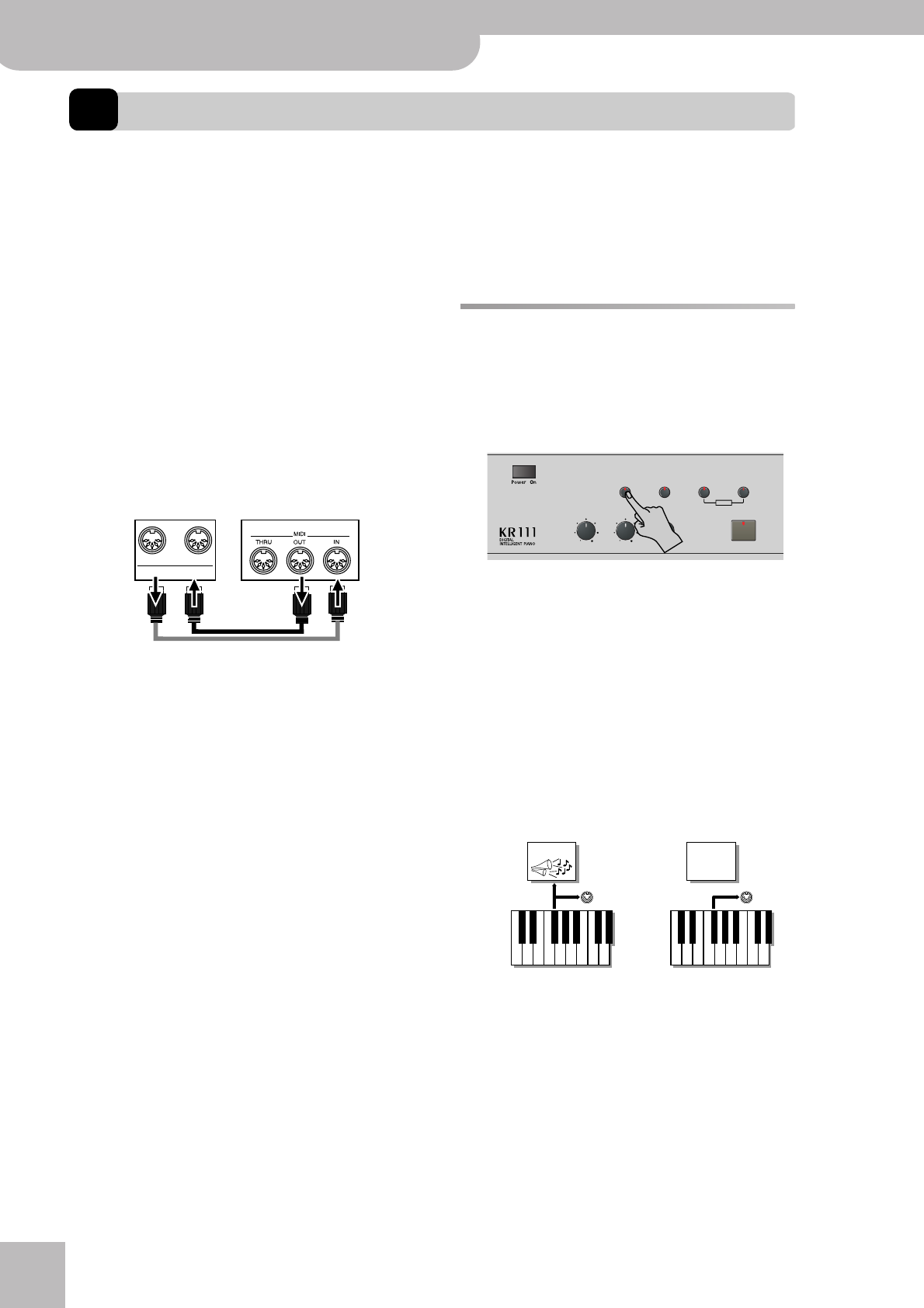
MIDI functions
52
r
KR111 Digital Intelligent Piano
14. MIDI functions
MIDI is short for “Musical Instrument Digital Interface”. The word refers to many things, the most obvious being a con-
nector type that is used by musical instruments and other devices to exchange messages relating to the act of making
music.
MIDI messages are transmitted and received using
three connectors and special MIDI cables:
• MIDI IN: This connector receives messages from other
MIDI devices.
• MIDI OUT: This connector transmits MIDI messages
generated on your KR111.
• MIDI THRU: This connector “echoes back” all MIDI
messages received via MIDI IN. The KR111 does not
provide a MIDI THRU connector.
Here is how to connect the KR111 to an external
sound module, sequencer, etc. When working with an
external sequencer, be sure to establish both connec-
tions and to set Local (page 52) to “Off”.
These sockets are located at the KR111’s bottom.
Note: You don’t always need two MIDI cables. Just look at
the arrows in the above illustration for deciding which
ports you need to connect the cable to.
You can also connect the KR111’s USB port to a USB
port of your computer, in which case the MIDI IN and
OUT connectors are bypassed. If you choose to work
with the USB port, you may have to install the appro-
priate drivers on your computer. See the “Readme”
files on the enclosed CD-ROM for details.
Caution
The KR111 only transmits “realtime” MIDI data. Thus,
only the notes you play on the keyboard as well as the
pedal data are transmitted (but not the Arranger or
Recorder data).
Note: The KR111 does not receive SysEx messages when the
Recorder is being used.
Each time you play on the KR111’s keyboard, your Digi-
tal Intelligent Piano transmits MIDI data to its MIDI OUT
socket (or USB port). If you connect the MIDI OUT
socket to the MIDI IN socket of another instrument,
that instrument may play the same notes as one of the
KR111’s parts, select sounds, etc.
Note: The KR111 receives on all MIDI channels assigned to the
various parts.
The KR111 contains the following MIDI parameters,
which are part of the Function group. Here is how to
select them and what they mean:
Editing MIDI parameters
You can edit the KR111’s Function parameters via the
display. Here is a general outline of the procedure for
all parameters discussed below:
(1) Press the [Function] button (its indicator must
light).
(2) Use [√][®] to select the parameter you wish to edit
(see below).
MIDI parameters
● Local—(On/Off, Default setting: On) The Local parame-
ter allows you to establish or remove the connection
between the KR111’s keyboard and the internal tone
generator.
When set to “ON” (default), playing on the KR111’s key-
board will cause the corresponding notes to sound. If
you select “OFF”, the corresponding MIDI messages are
no longer sent to the internal tone generator – but they
are still transmitted to the MIDI OUT port and hence to
external MIDI instruments.
Note: The setting of this parameter is not memorized
when you switch the KR111 off.
● TX Chnl—(1~16, Default setting: 1) This parameter
refers to the MIDI channel used for transmitting mes-
sages from the KR111 to external instruments (“TX” is
short for “transmit”). If the external instrument is set to
receive on (RX) MIDI channel 3, select “3” here. Other-
wise, the external instrument will neither play nor select
sounds, etc.
Note: MIDI messages sent from the external MIDI instru-
ment to the KR111 are received on all channels. However,
all keyboard information (of the Upper, Layer, Lower, chord,
and bass sound) will be transmitted on one channel.
External MIDI deviceKR-777/177
Out In
MIDI
KR111 External MIDI device
Reverb
Balance
Demo
Volume Brilliance
Function Part Balance Transpose
KeyboardAccomp
User Program
Sound source
MIDI OUT
LOCAL ON
LOCAL OFF
MIDI OUT
Sound source
Sound source Sound source


















